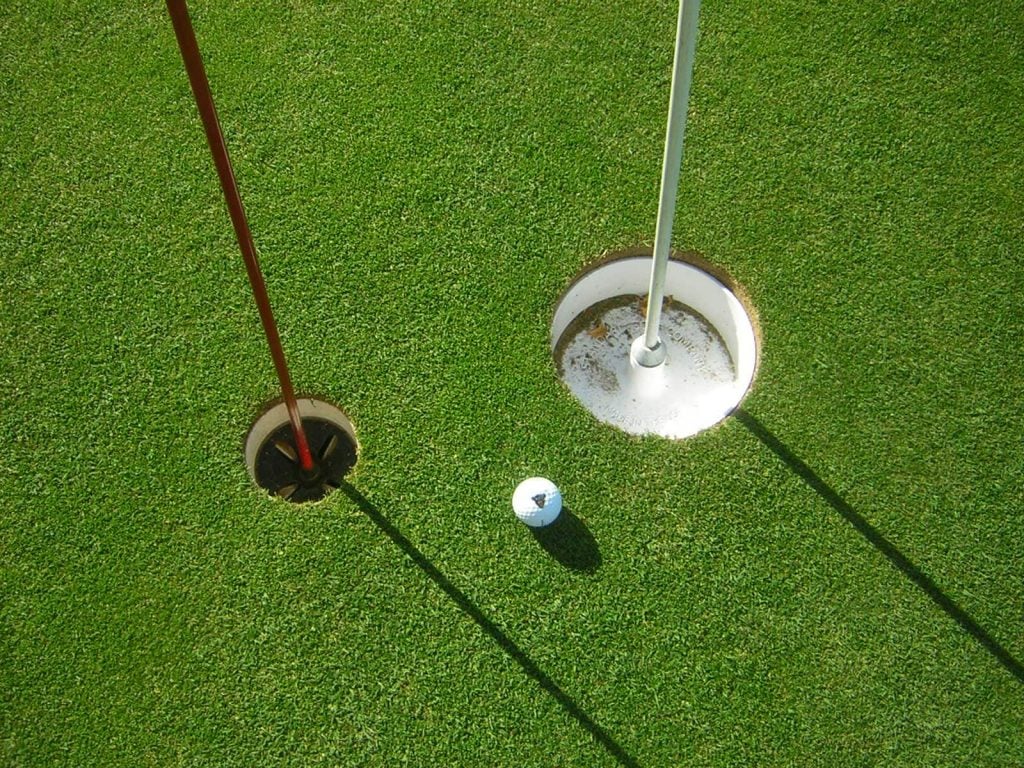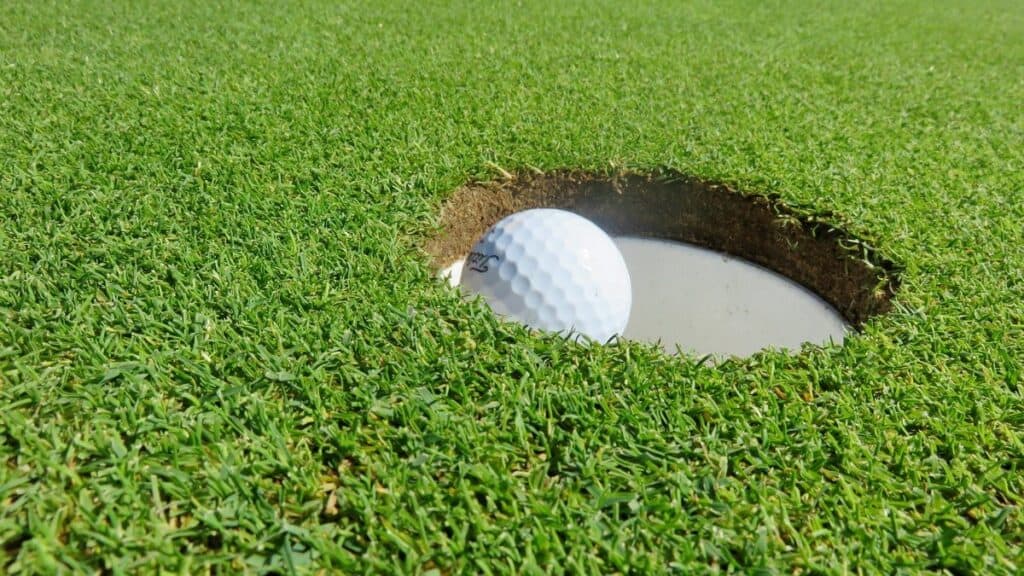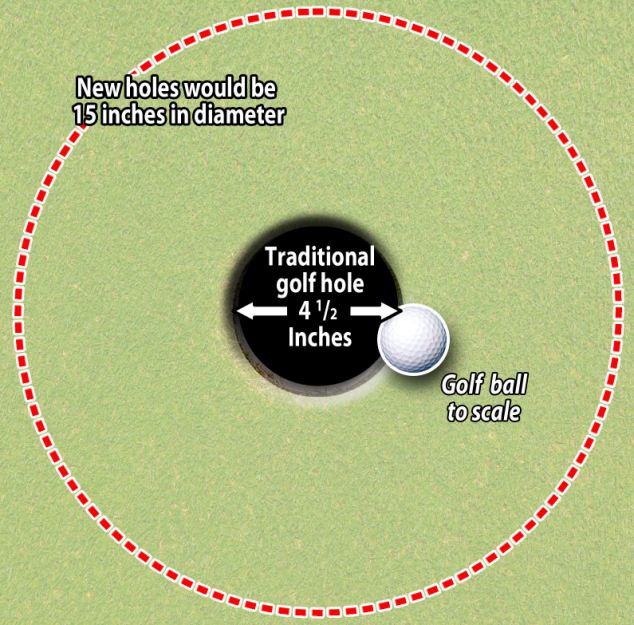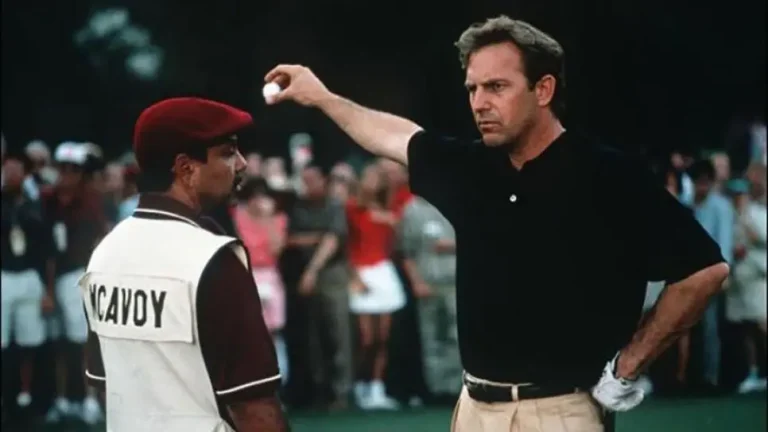Hitting the Target: How Big is the Golf Hole Really?
Key Takeaway:
- The standard size of a golf hole is regulated and is typically around 4.25 inches in diameter.
- There are variations in golf hole sizes, such as 15-inch holes for beginner and casual golfers, and 3-inch holes for practice on putting greens.
- To ensure consistency in golf hole size, precision measurement gadgets are used and there are standard lengths for flagsticks.
Introduction
The standard size of a golf hole dictates the challenge and precision that golfers face during gameplay. Understanding the dimensions of this crucial element in golf can shed light on the strategies and skills required to navigate the course successfully. In this section, we will explore the standard size of a golf hole and its implications in the game, uncovering fascinating insights that contribute to the overall experience for both amateur and professional golfers.

The Standard Size of a Golf Hole
Golfing has a standard size of a hole that is an important topic. Records go back to the start of this standard size, which is kept up in the sport. People argue to increase or keep the size of the hole. Variations are for beginners, casual golfers, and practice – usually with 3-inch holes on the putting green. Keeping it the same size is key.
Gadgets check the size with standard-length flagsticks. This info helps understand the size and importance of golf holes. Also, facts about minimum depth, number of golf courses in the US, and golf balls help to understand this.
The History of the Standard Hole Size
Golf hole size has been around for centuries. In the 15th century, when golf was first played in Scotland, holes were just shallow indentations in the ground without any set size or shape.
Over time, as the sport became more popular, standardization of hole sizes across various courses was needed. So, in 1891, the Royal and Ancient Golf Club of St Andrews made 4.25 inches the official diameter.
This size was picked for a few reasons. It offered a target that golfers of different skill levels could aim for. Also, it made putting easier, as players could judge distances on greens better.
Though people have suggested making the hole bigger for beginners and casual players, the 4.25-inch diameter still stands. Plus, it is hard to find out about any prior variations in size due to a lack of records.
The Regulation of Golf Hole Size
Golf hole size regulation has been a topic of discussion for some time. It has evolved over the years, and people have opinions on whether it should be changed.

Originally, holes were just natural depressions. But, as golf developed, a standard size was set. Now, USGA and R&A control it to ensure fairness in courses.
Those in favour of bigger holes think it would make the game easier and more fun for beginners and casual golfers. They believe it would speed up play and increase popularity.
Though there have been talks of larger holes, nothing has been done about it.
Opposers think bigger holes would make golf like mini-golf for giants.
Arguments for and against a Larger Hole Size
The size of a golf hole has been a hot topic among golfers. Some call for a bigger hole, but others disagree. Those who support a larger size say it makes the game simpler for beginners and casual golfers. Plus, it could quicken up rounds. And, it makes putting less of a hassle.
However, opponents think it will take away from the skill and strategy needed to be good at golf. Additionally, they don’t want to have different hole sizes depending on the course. They also worry it can affect rankings and ratings in competitive play.
It’s important to consider both perspectives when deciding golf hole sizes, as they affect all kinds of players.
Variations in Golf Hole Size
When it comes to golf hole sizes, there are some interesting variations to consider. From 15-inch holes designed for beginner and casual golfers to putting greens with 3-inch holes specifically for practice, the golfing world offers a range of options. Whether you’re looking to challenge yourself or sharpen your skills, understanding these variations can add a new level of excitement to your golfing experience.

15-Inch Holes for Beginner and Casual Golfers
Golf courses have added 15-inch holes for beginner and casual golfers. The bigger hole makes the game more enjoyable and easier. Novices have a wider target to aim for, providing them with achievement and satisfaction when they get the ball in.
- These larger holes make it simpler for newbies to focus on their technique without extra pressure.
- With a bigger hole, beginner golfers can gain trust in their putting skills. This increases their enthusiasm to keep playing and cheers up their overall experience.
- The use of 15-inch holes also speeds up play, as beginners are not likely to spend too much time trying to sink their shots. This decreases possible irritation and boosts the fun for all players.
Take note: these bigger holes are usually found in specific areas made for beginners or during practice sessions. The idea is not to change the standard gameplay rules but to give an alternative that helps skill development and joy for casual or less experienced players.
Putting Greens with 3-Inch Holes for Practice
Putting greens with 3-inch holes are especially made for golfers to practice their putting techniques. It presents a smaller target than the standard hole size, making it harder for golfers to better their accuracy and precision. These practice greens are made to sharpen a golfer’s capability to detect slopes and break, as well as create a consistent stroke.
A 3-step guide for using putting greens with 3-inch holes for practice:
- Select the right putter. Pick a putter which feels okay in your hands and matches your stroke style. Experiment and discover a putter which lets you have consistency in your stroke.
- Focus on alignment and distance control. Put the golf ball just away from the center of your stance, arranging it with the target line. Focus on keeping proper alignment through your stroke. Moreover, work on distance control by practicing different length putts from different distances.
- Develop feel and touch. Practicing with smaller holes demands more accuracy in speed and approach. Emphasize creating a smooth stroke which allows for effective feel and touch when hitting the ball into the smaller hole.
This type of practice helps golfers refine their putting skills by requiring higher accuracy due to the smaller size of the hole. The use of putting greens with 3-inch holes also encourages golfers to concentrate on elements such as clubhead speed, ball contact, and green reading skills. By practicing on these smaller targets, golfers can obtain assurance in their putting abilities and enhance their performance on standard-sized greens during real gameplay.
Gadgets and flagsticks may help keep consistency in golf hole size, but they won’t stop your ball from finding the one patch of grass encircled by sand.
Ensuring Consistency in Golf Hole Size
Ensuring consistency in golf hole size is crucial for a fair and challenging game. Discover how the use of gadgets for precision measurement and understanding the standard length of flagsticks play key roles in maintaining accuracy on the course. Get ready to delve into the world of golf hole sizing and the technical aspects that impact the game.
The Use of Gadgets for Precision Measurement
Golf hole size can be gauged precisely with specialized gadgets. These tools guarantee accurate measurement, letting golf course officials keep uniformity in hole size across all courses. By utilizing these gadgets, golf courses can make sure that the standard hole size is maintained, giving a fair and consistent playing experience for all golfers.
Moreover, these gadgets offer other exclusive features. Certain gadgets may have built-in leveling systems or automatic flagstick alignment functions, further helping with precise measurements and keeping consistency on the golf course. These extra functionalities amplify the effectiveness of keeping proper hole sizes and add to an optimal playing experience for golfers of all skill levels.
The Standard Length of Flagsticks
The standard length of flagsticks in golf is essential. It guarantees fairness and consistency on the putting greens. Players trust the flagstick as a dependable reference point all round.
Various golf courses may have slight variations. But they are usually minor and meant to maintain consistency within a course, not significantly diverge from the standards.
Golf course operators should use precision measurement equipment. Laser range finders or similar gadgets make sure flagsticks are in conformity with the standard length.
Adhering to the standard length of flagsticks is crucial. It gives players a reliable reference point to gauge distances and make wise decisions during their rounds.
Conclusion
The article, “How Big is the Golf Hole?“, offers insight on the hole’s size. The USGA states that a standard golf hole has a 4.25 inch diameter. This measurement has remained unchanged for years, ensuring fairness and consistency in golf.
In addition to size, other factors such as contour and slope of the green can affect difficulty. They add a new layer of challenge and require golfers to assess their skills and strategies.
Overall, the article shows the golf hole’s size and importance. It helps players plan and navigate the game’s challenges. Ultimately, it enables a more informed and enjoyable golfing experience.
Some Facts About How Big Is the Golf Hole:
- ✅ The standard size of a golf hole is a circle with a 4.25 diameter all the way around. (Source: GolfSpan)
- ✅ Most golf courses in the world follow this universal size for golf holes. (Source: GolfSpan)
- ✅ Some golf courses now offer 15-inch holes for beginner and casual golfers. (Source: GolfSpan)
- ✅ There are no golf courses with smaller holes than the standard size, but there are putting greens with 3-inch holes for practice. (Source: GolfSpan)
- ✅ Gadgets are used to ensure that all golf holes are the same size, rather than relying on human measurement. (Source: GolfSpan)
FAQs about How Big Is The Golf Hole
How big is the golf hole and why is it a standard size?
The standard size of a golf hole is 4¼ inches in diameter. This size has been the accepted norm since 1891 when the Royal and Ancient Golf Club of St Andrews included it in their rule book. The Royal Musselburgh Golf Club invented the first known hole-cutter in 1829, which measured exactly 4¼ inches, based on the typical size of a Musselburgh drainage pipe at the time. The reason for this precise diameter is unknown.
Are there any variations in the size of golf holes?
Most golf courses around the world follow the standard 4¼ inch size for golf holes. However, some courses now offer larger 15-inch holes for beginner and casual golfers. Additionally, there are putting greens with smaller 3-inch holes specifically for practice purposes.
What is the minimum depth of a golf hole?
While there is no mandatory depth for a golf hole, it must be at least 4 inches deep. This allows the ball to be securely held within the hole.
Who determines the regulations for the size of the golf ball and hole?
The size of the golf ball and hole is regulated by the USGA (United States Golf Association) and R&A (The Royal and Ancient Golf Club of St Andrews), which are the governing bodies responsible for making the Rules of Golf.
Has there been any discussion about changing the size of the golf hole?
There has been an ongoing debate about the merits of a larger hole, which would reduce the emphasis on putting and reward accurate approach play. Golf legends Ben Hogan and Gene Sarazen were advocates of a larger hole size. However, currently, there is no official agenda to change the standard hole size.
Why are cookies required to view some golf-related websites?
Some golf-related websites, like golfcourseindustry.com, use a security service to protect against online attacks. This service requires users to enable cookies on their browsers in order to access the website. Cookies help verify the user’s authenticity and prevent bot attacks. Once the validation is complete, users can view the website content.








